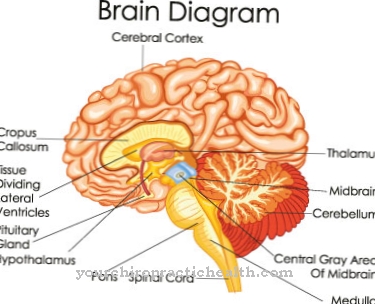The Diaphragmatic palsy or Diaphragmatic palsy is caused by paralysis of the phrenic nerve (diaphragmatic nerve). It comes from the third to fifth neck segment of the spinal cord and activates the diaphragm and several other organs in the chest, such as the pericardium. A paralysis of the nerve leads to relaxation of the diaphragm on the affected side. This pushes the abdominal organs upwards because the diaphragm can no longer hold them down.
What is diaphragmatic palsy?
The diaphragm is made up of muscles and tendons, is located below the costal arch and separates the chest cavity from the abdomen. It is dome-shaped and reaches an average thickness of three to five millimeters. Its functioning depends directly on the phrenic nerve. If this is injured or paralyzed, the diaphragm can only fulfill its function as a respiratory muscle to a limited extent or no longer.
There is also the risk that tumors of the lungs and other chest or abdominal organs will shift into the diaphragm. Parts of the diaphragm may then need to be removed and replaced. A Diaphragmatic palsy can also result from nerve damage caused by surgery or external influences such as gunshot wounds. If it develops without an understandable cause of the disease, it is called idiopathic diaphragmatic palsy designated.
causes
Every diaphragmatic palsy has a major impact on human breathing. Diaphragmatic breathing pumps two thirds to four fifths of the air you breathe through your body. When you breathe in, the diaphragm is supported by additional muscles that lift the ribs and thus enlarge the chest. This process is also called chest breathing.
Even with complete paralysis of the diaphragm, it can ensure adequate ventilation of the lungs, but only in a state of rest and low stress. The diaphragm works on the principle of contraction. It contracts when you inhale and becomes around a third shorter in the process. At the same time, it flattens out and takes on a cone shape.
The contracting diaphragm shifts the organs in the upper abdomen, but this is compensated for again due to the relaxation of the abdominal muscles and bulging of the abdominal wall. The organs retain their necessary space and the pressure conditions in the abdominal cavity remain the same. With each exhalation, the diaphragm loosens again. During this process, the lungs contract and the diaphragm changes back to its dome shape.
If the phrenic nerve becomes cramped, it manifests itself in what are known as hiccups. The largely harmless side stitches also have such causes. The insufficient supply of oxygen to the diaphragm plays a major role here. However, diaphragmatic spasms in connection with tetanus can be very dangerous for life and limb.
A distinction must be made between unilateral and bilateral diaphragmatic paralysis. In the unilateral form, damage to the phrenic nerve can be due to tumors, such as bronchial carcinoma, lymphoma of the mediastinum or neurofibromas. Aortic aneurysms or abscesses are also possible causes. Traumas such as a thoracic trauma or viral infections (herpes zoster) can also cause one-sided diaphragmatic paralysis.
Infections caused by viruses or bacteria are more rarely responsible for a paralyzed diaphragm. However, these can affect all organs in the upper body. Since the phrenic nerve anatomically belongs to the arm nerve plexus, its paralysis can also be related to a so-called shoulder-arm weakness. In addition, advanced wear and tear of the cervical spine is a possible cause.
The bilateral form can be favored by neuropathies such as alcohol poisoning, lead poisoning or porphyria. Possible reasons include a spinal cord injury, syringomyelia, or neuromuscular diseases such as ALS.
Symptoms, ailments & signs
In most cases, diaphragmatic palsy only appears on one side. It can be congenital, but the most common causes are cancerous ulcers. If these settle in the lungs, for example, or if a diseased lymph node develops, the diaphragmatic nerve quickly gets into trouble and no longer works properly.
Unilateral paralysis of the diaphragm is often barely noticed by the sick. Difficulty breathing here mostly only occurs with greater physical activity. However, if the lungs are not properly ventilated on one side, dangerous dangers lurk. Then it is very sensitive to inflammation caused by infections.
In the case of bilateral diaphragmatic paralysis, greater or lesser dyspnoea is recorded in any case. Affected people can then often not sleep lying flat, because the diaphragm is the only active breathing muscle during longer phases of sleep. If you are very lucky, this deficiency can only be avoided by breathing in which the upper body is upright and the arms are propped up.
Diagnosis & course of disease
X-rays and ultrasound make a unilateral diaphragmatic palsy clearly visible. The paralyzed side of the organ is always a bit higher than the healthy one. In addition, parameters of the respiratory function and respiratory pressure values can be measured, which allow conclusions to be drawn about the activity of the diaphragm. A blood gas analysis can also be useful for diagnosis. Lung function tests provide information about the degree of breathing difficulties. In addition, a thorough and long-term examination of the patient in the sleep laboratory is up for debate.
Complications
Diaphragmatic palsy is a very serious complaint that, in the worst case, can lead to the death of the person affected. The further course of this disease depends very much on the exact cause of the diaphragmatic palsy, with life expectancy being significantly reduced in most cases. Those affected suffer from breathing difficulties and possibly from tiredness and fatigue.
Inflammations and infections in the airways are very common and can significantly reduce the quality of life. It can also cause shortness of breath, so that in severe cases the patient can lose consciousness. Exhausting activities or sporting activities are no longer possible for the patient.
The treatment of diaphragmatic palsy depends very much on the underlying disease, which must be treated primarily. If the disease is triggered by a tumor, it can often no longer be completely cured and the patient dies prematurely. In other cases, diaphragmatic palsy requires surgical interventions to alleviate the symptoms. The treatment itself is not associated with any further complications.
When should you go to the doctor?
A doctor is required as soon as the person concerned perceives their condition deteriorating over several days or weeks. If his physical or mental performance drops, if he feels unwell or if he feels sick, action is required. Special care should be taken in the event of breathing difficulties. If these cannot be attributed to temporary overexertion, they are often a warning signal from the organism. Respiratory disorders should therefore be examined by a doctor immediately if they persist for several days. An increase in symptoms is particularly worrying. If you experience anxiety or sleep disorders, you should consult a doctor as soon as possible.
A feeling of pressure in the chest, tightness or the inability to breathe deeply are signs of a health problem. If physical activity leads to fatigue very quickly, action must be taken. A doctor should be seen immediately so that the cause can be clarified and a diagnosis can be made. If the person concerned wakes up from sleep due to a lack of oxygen, a doctor should be consulted. If breathing is impaired as soon as physical positions are changed, this is also a cause for concern. An increased susceptibility to inflammatory diseases, a slightly increased body temperature or internal irritation are other complaints that should be investigated.
Treatment & Therapy
If the diaphragmatic palsy is still in the early stages and not very pronounced, physiotherapy is sometimes sufficient. In more serious cases, a diaphragm may need to be tightened.
You can find your medication here
➔ Medication for shortness of breath and lung problemsprevention
Since diaphragmatic palsy is often the result of a previous disease and these have very different forms, general prevention is hardly possible. However, a healthy lifestyle with plenty of exercise and a balanced diet is recommended as a preventative measure. If you spend a lot of time sitting for work, it is advisable to do back exercises regularly to prevent wear and tear on the back muscles.
Aftercare
In most cases, sufferers of diaphragmatic palsy have only a few and only very limited measures available for direct follow-up care. Therefore, those affected with this disease should consult a doctor as early as possible and initiate treatment in order to prevent further complications and complaints from occurring.
Self-healing cannot occur, so treatment by a doctor is always necessary. The earlier a doctor is consulted in the case of diaphragmatic palsy, the better the further course of the disease. As a rule, those affected with diaphragmatic palsy are dependent on the measures of physiotherapy and physiotherapy.
As a result, most complaints can be permanently limited and alleviated. Furthermore, the support of one's own family in everyday life is often very important and can help prevent depressive moods. Contact with other sufferers of diaphragmatic palsy can also prove to be very useful and make everyday life easier for those affected.
Exercise a lot and follow a healthy lifestyle. Obesity should also be avoided. In most cases, this disease does not reduce the life expectancy of the person affected, nor does it continue to limit it.
You can do that yourself
In most cases, diaphragmatic palsy has limitations. Depending on the severity and cause of the disease, coping with everyday activities is not possible or only possible with great effort. Patients' quality of life is also often significantly reduced by regular respiratory infections.
Those affected usually suffer from shortness of breath even with little exertion. For this reason, people with diaphragmatic palsy should neither exercise nor engage in strenuous activities. Certain relaxation techniques such as meditation can be helpful, but these should only be used in consultation with the treating doctor. However, yoga or Pilates is not advisable. Furthermore, the sick usually have an increased need for sleep. You should therefore take regular breaks.
Basically, those affected should avoid stress of any kind. A stable social environment and a healthy lifestyle are important. Ideally, the sick are supported by relatives or family members. Otherwise, in some cases, professional care is required. Those affected should eat a healthy diet and avoid alcoholic beverages and coffee. Smoking must be stopped immediately in the case of diaphragmatic palsy.



























